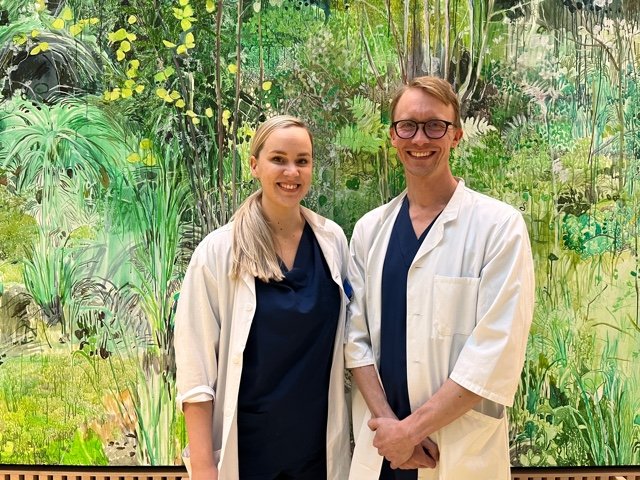Is a partial removal of tonsils a better option than traditional surgery also for adult patients?
The traditional removal of tonsils (tonsillectomy) is a common surgical procedure. Recovery from the operation, however, is painful and slow. Long sick leaves also present a burden for society. Our research team aims to investigate whether adult patients recover faster from the partial removal of tonsils in comparison to the recovery time for a traditional tonsillectomy.Published: 8.1.2025
Text and pictures: Lotta Ivaska
Editing: Viestintätoimisto Jokiranta Oy
“You will have pain in your throat for two weeks after the procedure. You may need to take a sick leave and regular pain medication. This procedure comes with a risk of post-operative bleeding that may call for hospital care.”
This instruction is my way of preparing adult patients for the surgical removal of their tonsils. Tonsillectomy, or the operation involving the total removal of tonsils, is a general surgical procedure in Finland. Horror stories circulate about the long and painful recovery after surgery, bleeding in the throat and no relief of the pain with even the strongest pain killers.
A classic tonsillectomy is still one of the most common procedures in the field of ear, nose and throat diseases (otorhinolaryngology). In Finland, a total of around 6,500 tonsillectomies are performed annually (THL 2019). Surgical methods have developed over the years and more attention is paid to the pain management. Nevertheless, tonsillectomy is still rated as an operation that is followed by a very painful recovery period.
Is a tissue-saving tonsil surgery a feasible option for adults as well?
In traditional tonsillectomy, the tonsils are completely removed, along with the surrounding capsule. The capsule contains muscle nerve fibres and blood vessels, which will, of course, be damaged during the procedure. The damage does heal over time, but it takes two weeks for the patient to recover and there is a risk of post-operative bleeding.
In children, a usual reason for the removal of tonsils is the excessive growth (hypertrophy) of the tonsil tissue and subsequent breathing problems during sleep. Based on researched information, the traditional tonsillectomy is increasingly being replaced by a tissue-saving method, in which only a part of the tonsil tissue is removed and the capsule remains untouched. Symptoms caused by tonsil hypertrophy are relieved, the recovery is faster and the risk of post-operative bleeding is smaller as compared to a traditional tonsillectomy.
In adults, the usual indication for a tonsillectomy is a chronic or recurrent infection (tonsillitis), sometimes also the large size of tonsils and related sleep disorders. Our research team aims to investigate whether the partial removal of tonsils is a feasible option for adult patients as well.

Researched information for optimised clinical practice
Originally, the research project FINITE (Finnish Intracapsular Tonsillectomy Trial) focused on comparing the recovery of adult patients from a partial removal of tonsils vs. a traditional tonsillectomy. In addition, the use of pain medication, the occurrence of post-operative bleeding during recovery, the quality of life, the volume of residual tonsil tissue and the number of pharyngitis episodes were examined over a six-month follow-up period. The results are promising: the recovery appears to be faster and the data from the six-month follow-up suggest that both techniques are equally efficient.
In the next phase, we will study the duration of the sick leave needed and the optimisation of pain medication. The intention is to recruit study subjects from among adult patients undergoing tonsil surgery. We will use questionnaires and control phone calls in order to clarify whether a shorter sick leave and pain medication with anti-inflammatory drugs and paracetamol are sufficient after a partial removal of tonsils.
If supported by the outcome of the research, the partial removal of tonsils may become a more common clinical option for adult patients in the near future. The change would be significant both in terms of the financial burden on society and the recovery of an individual patient, as the traditional tonsillectomy is commonly associated with a slow and painful recovery. For optimised clinical practices, additional researched information about different surgical methods is needed. A randomised controlled trial is the best research method for this purpose.

Lotta Ivaska, MD, PhD, is working as a Specialist in Otorhinolaryngology (ear, nose and throat diseases) at Turku University Hospital (Tyks) and a Clinical Lecturer at the University of Turku. Her doctoral dissertation in 2022 concerned tonsillar microbiome, viruses and immune responses. In addition to her clinical work, she serves as a postdoctoral researcher on a research team focusing on the study of surgical methods related to tonsils.
Picture 1: Doctoral researchers and supervisory members of the research team. From the left: MD Jenny Knubb, doctoral researcher; MD Henrik Sjöblom, doctoral researcher; MD, PhD Lotta Ivaska, postdoctoral researcher; MD, PhD Jaakko Piitulainen, Principal Investigator.
Picture 2: Our research group also includes doctoral candidates MD Jenni Ylikoski and MD Tapani Uusitalo.
